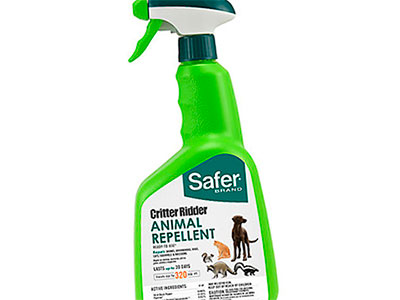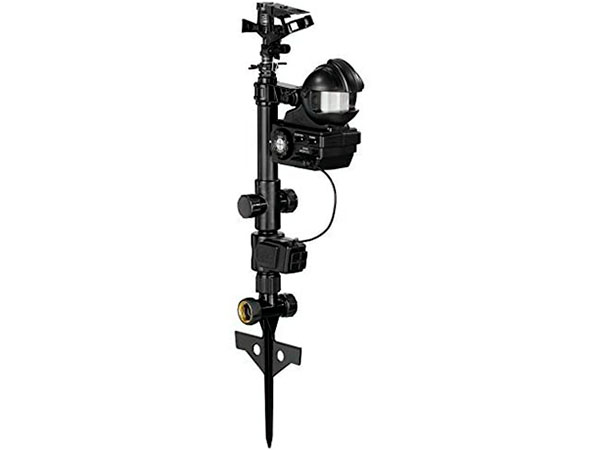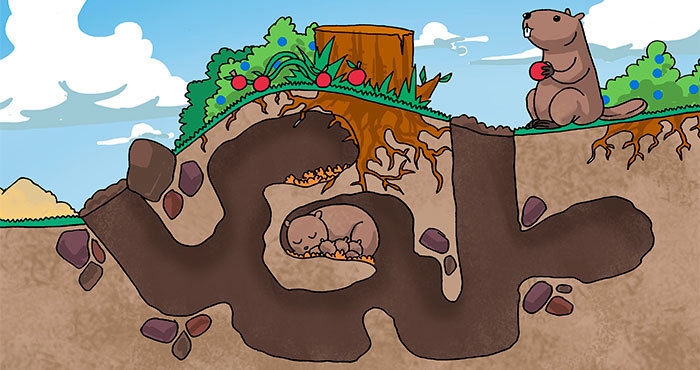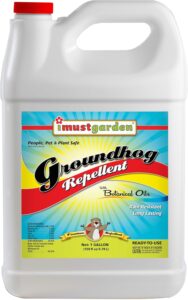Dealing with groundhogs on your property? These burrowing rodents can cause significant damage to gardens, lawns, and even structural foundations. This comprehensive guide provides humane, effective methods how to get rid of groundhogs and prevent their return, helping you solve your wildlife problem while respecting nature’s balance.
Quick Picks: How to Get Rid of Groundhogs

Most Effective

Safest Option

No Contact
- Understanding Groundhog Behavior and Damage
- Humane Live Trapping: The Most Effective Approach
- Exclusion Methods: Preventing Groundhog Access
- Natural and Commercial Repellents
- Electronic and Mechanical Deterrents
- Habitat Modification Strategies
- Professional Wildlife Removal Services
- Integrated Groundhog Management Plan
- Frequently Asked Questions
- Conclusion
Understanding Groundhog Behavior and Damage
Groundhogs (Marmota monax), also known as woodchucks or whistle pigs, are large burrowing rodents that can weigh up to 15 pounds. While they play important ecological roles in nature, they can become problematic when they take up residence on your property.

Garden Damage
Groundhogs consume up to 1.5 pounds of vegetation daily, causing extensive damage to vegetable gardens, ornamental plants, and fruit trees.
Structural Issues
Their extensive burrow systems can compromise foundations, patios, decks, and retaining walls, potentially leading to costly repairs.
Safety Hazards
Burrow entrances create trip hazards for people and can cause injuries to livestock or damage to farm equipment.
Before attempting any groundhog control methods, it’s important to confirm you’re dealing with groundhogs and not other burrowing animals like moles or voles. Groundhog burrows typically have entrance holes 10-12 inches in diameter with mounds of excavated soil nearby. You’ll often see multiple entrance holes leading to the same burrow system.
Humane Live Trapping: The Most Effective Approach
Live trapping is widely considered the most effective and humane method for removing groundhogs from residential areas. This approach allows you to capture the animal without harm and relocate it to a more suitable habitat.

Choosing the Right Live Trap
For successful groundhog trapping, you’ll need a properly sized live trap with these characteristics:
- Size: 30-42 inches long, 10-12 inches high, and 10-12 inches wide
- Material: Heavy-gauge wire or metal to withstand groundhog strength
- Design: Single or double-door models (double-door traps often have higher success rates)
- Trigger mechanism: Sensitive enough to trigger when a groundhog steps on it, but not so sensitive it causes false triggers
For detailed reviews of the best groundhog traps available in 2025, visit our groundhog trap guide.
Trap Placement and Setup
Effective Trap Placement Tips
- Position traps 5-10 feet from active burrow entrances
- Place traps along established groundhog paths or near damaged gardens
- Ensure the trap sits on level ground to prevent tipping or malfunction
- Camouflage the trap with natural materials (grass, leaves, branches) to reduce wariness
- Create a funnel effect with logs or boards to direct groundhogs toward the trap entrance
Best Baits for Groundhog Trapping

Groundhogs are herbivores with a preference for fresh fruits and vegetables. The most effective baits include:
Fruits
Cantaloupe (with rind), strawberries, peaches, or apples – all known favorites
Vegetables
Fresh lettuce, green beans, peas, broccoli, or carrots with tops
Garden Favorites
Use plants the groundhog has already been feeding on in your garden
Humane Handling and Relocation
Once you’ve captured a groundhog, follow these steps for safe and humane relocation:
- Approach carefullyCover the trap with a light blanket to reduce stress on the animal and protect yourself from potential bites or scratches.
- Wear protective glovesAlways wear thick gloves when handling the trap to protect yourself and prevent transferring your scent to the trap.
- Transport properlyKeep the trap level during transportation and avoid excessive heat or cold exposure.
- Choose an appropriate release siteRelocate the groundhog at least 5 miles from your property in a suitable habitat (fields with cover, wooded areas with clearings, etc.).
- Release carefullyPlace the trap on level ground, stand back, open the door, and allow the animal to leave at its own pace.
Exclusion Methods: Preventing Groundhog Access
Creating physical barriers is one of the most effective long-term solutions for groundhog problems. Proper exclusion techniques can permanently protect gardens, structures, and landscaped areas.

Fencing That Works
Standard fencing often fails to deter groundhogs because they can both climb and dig. For effective groundhog exclusion, your fence needs these specific features:
Height
Minimum 3 feet tall to prevent jumping
Climbing Barrier
Top 12-15 inches bent outward at a 45° angle
Digging Barrier
Bottom portion extended 12 inches underground in an L-shape extending outward
Material
Welded wire or heavy-gauge mesh with openings 2 inches or smaller
Protecting Specific Structures
For decks, sheds, porches, and other structures that groundhogs often burrow under:
- Trench Barriers: Dig a 1-foot deep trench around the perimeter and install hardware cloth or metal flashing in an L-shape extending outward.
- Fill-in Methods: For abandoned burrows, fill with a mixture of soil and gravel after confirming no animals remain inside.
- Concrete or Stone: Consider creating a concrete footer or stone barrier around structure perimeters.
Natural and Commercial Repellents
Repellents can be effective as part of an integrated groundhog management approach, particularly for deterring groundhogs from gardens and landscaped areas.
Commercial Groundhog Repellents
For detailed information on commercial groundhog repellents, visit our comprehensive groundhog repellent guide. The most effective commercial options include: These products utilize various ingredients and methods to deter groundhogs effectively. For an in-depth analysis of efficacy and user experiences, check out our section on the best groundhog repellents reviewed. By choosing a well-reviewed repellent, you can enhance your chances of keeping these pesky rodents at bay.
- Predator Urine Products: Containing fox or coyote urine to trigger fear responses
- Granular Repellents: Typically containing castor oil or natural irritants
- Liquid Spray Repellents: Applied directly to plants and surfaces groundhogs may feed on
DIY Natural Repellent Solutions
Hot Pepper Solution
Mix 1 tablespoon cayenne pepper, 2 tablespoons crushed garlic, and a few drops of dish soap in 1 gallon of water. Spray around burrow entrances and garden perimeters.
Pet Hair Barrier
Collect dog or cat hair and sprinkle around garden edges and near burrow entrances. The scent of predators can deter groundhogs.
Epsom Salt Solution
Dissolve 2 cups of Epsom salt in 1 gallon of water and spray around the perimeter of your garden. Reapply after rain.
Human Hair
Place human hair (collected from hairbrushes or obtained from salons) in mesh bags and hang near groundhog activity areas.
Repellent Plants
Certain plants naturally repel groundhogs due to their strong scents or unpalatable characteristics. Consider planting these around garden perimeters or near groundhog burrows:
- Herbs: Mint, lavender, thyme, oregano, rosemary, sage
- Flowers: Marigolds, nasturtiums, geraniums
- Vegetables: Garlic, onions, hot peppers
- Other: Crown imperial, daffodils, alliums
Electronic and Mechanical Deterrents
Various devices can create uncomfortable environments for groundhogs without direct contact or harm.
Motion-Activated Devices
Motion-activated deterrents detect movement and trigger responses that frighten groundhogs away:
| Device Type | How It Works | Effectiveness | Best Placement | Maintenance |
|---|---|---|---|---|
| Motion-Activated Sprinklers | Detects movement and releases sudden bursts of water | High | Near burrow entrances, garden perimeters | Check batteries and water connection regularly |
| Ultrasonic Repellers | Emits high-frequency sounds uncomfortable to groundhogs | Moderate | Near burrow entrances, 20-30 ft spacing | Check batteries, solar panel cleaning |
| Strobe Lights | Flashing lights that disturb nocturnal movements | Moderate | Facing burrow entrances | Check batteries, clean solar panels |
| Wind-Activated Noise Makers | Creates unpredictable sounds and vibrations | Low-Moderate | Garden perimeters, near feeding areas | Minimal, reposition occasionally |
Recommended Electronic Deterrent: Motion-Activated Sprinkler
The Orbit Yard Enforcer creates a harmless but effective deterrent by combining sudden water spray with unexpected noise. This humane solution protects up to 1,600 square feet and teaches groundhogs to avoid your property.
Key Features:
- Intelligent motion detection up to 40 feet away
- Day, night, or 24-hour operation modes
- Adjustable spray distance and width
- Water-efficient design uses minimal water per activation
- No harmful chemicals or permanent effects on wildlife
Habitat Modification Strategies
Making your property less attractive to groundhogs can be an effective long-term prevention strategy. These modifications discourage groundhogs from establishing burrows or feeding areas.
Vegetation Management
Keep grass short (under 4 inches) and remove brush piles, tall weeds, and overgrown areas that provide cover. Trim lower branches of shrubs to eliminate hiding spots.
Food Source Reduction
Harvest fruits and vegetables promptly. Remove fallen fruit. Consider using raised garden beds with hardware cloth bottoms to prevent access.
Drainage Improvement
Improve drainage in low-lying areas. Groundhogs prefer well-drained soil for their burrows and avoid consistently wet areas.
Debris Removal
Remove woodpiles, rock piles, abandoned equipment, and other debris that could provide shelter or burrow locations.
Professional Wildlife Removal Services
When groundhog problems are severe, persistent, or in sensitive locations (like under structures), professional wildlife removal services offer expertise and specialized equipment.
When to Consider Professional Help
- Multiple groundhogs or extensive burrow systems
- Burrows under structures that risk foundation damage
- Failed DIY removal attempts
- Lack of time or ability to implement proper trapping
- Legal restrictions on DIY wildlife management in your area
Choosing a Wildlife Removal Professional
What to Look For in a Wildlife Service
- Proper licensing and insurance
- Humane removal methods and practices
- Comprehensive approach including exclusion and prevention
- Written estimates and guarantees
- Positive reviews and testimonials
- Experience specifically with groundhog removal
Professional services typically charge $150-$500 for groundhog removal, depending on the complexity of the situation, number of animals, and necessary exclusion work.
Integrated Groundhog Management Plan
The most successful approach to groundhog control combines multiple methods in a strategic sequence. Here’s a comprehensive step-by-step plan:
- Identify and assessConfirm groundhog presence, locate all burrow entrances, and document damage areas.
- Implement immediate deterrentsApply repellents and set up deterrent devices to begin discouraging groundhog activity.
- Trap and relocateUse live traps baited with attractive foods to capture groundhogs humanely.
- Exclude accessOnce groundhogs are removed, install proper fencing and burrow barriers to prevent return.
- Modify habitatMake your property less attractive by eliminating shelter and excess food sources.
- Monitor and maintainRegularly check for new activity and maintain repellents, fences, and deterrents.
Frequently Asked Questions
How can I tell if a groundhog burrow is active?
Active groundhog burrows have clear, unobstructed openings with fresh dirt around the entrance. To confirm activity, place loose materials like newspaper, straw, or leaves in the entrance and check if they’ve been disturbed after 24-48 hours. You can also sprinkle flour around the entrance to detect footprints.
Groundhogs typically maintain multiple entrances to their burrow systems, so identifying all openings is important for effective control.
Is it legal to trap and relocate groundhogs?
Regulations vary significantly by location. In many states, groundhogs are classified as nuisance wildlife, and property owners can legally trap them. However, there may be restrictions on relocation distances, crossing county lines, or permit requirements.
Always check with your state’s wildlife agency or local animal control before trapping to ensure compliance with current regulations in your area.
Will groundhogs return after being relocated?
Groundhogs relocated less than 3 miles away may find their way back to their original territory. Research indicates a minimum relocation distance of 5 miles is necessary to prevent return, along with prompt exclusion measures to prevent new groundhogs from occupying the vacant burrow system.
Choose release sites with suitable habitat and natural cover to encourage the groundhog to establish a new territory rather than attempting to return.
How deep do groundhog burrows go?
Groundhog burrows typically extend 2-5 feet below the ground surface, though some main chambers can be as deep as 6 feet. Horizontally, burrow systems can extend 15-25 feet, with multiple chambers for nesting, food storage, and waste.
This extensive burrowing capability is why exclusion barriers need to extend at least 12 inches underground with an outward-facing L-shape to prevent digging under fences.
What should I do if I find baby groundhogs?
If you discover baby groundhogs (typically born in April-May), it’s best to wait until they’re old enough to leave the nest (usually by mid-summer) before attempting removal. Separating mothers from dependent young is both inhumane and ineffective, as the young will likely die without maternal care.
Consider using temporary deterrents to minimize damage until the family can be safely removed as a unit or the young are independent.
Conclusion
Managing groundhog problems effectively requires a combination of understanding groundhog behavior, implementing the right removal techniques, and taking preventative measures to avoid future issues. By following the humane approaches outlined in this guide, you can successfully resolve groundhog conflicts while respecting wildlife.
Remember that groundhogs, despite the challenges they may present to homeowners, play important ecological roles in natural ecosystems. Their burrowing aerates soil and provides habitat for other species, while their feeding habits can help control certain plant populations. When possible, focus on exclusion and deterrence rather than elimination.
For persistent or complex groundhog problems, don’t hesitate to consult with professional wildlife management services who can provide humane, effective solutions tailored to your specific situation.
For more information on specific groundhog control products, visit our detailed guides on groundhog traps and groundhog repellents.



Try Giant Destroyer fumigating tunnel will kill groundhogs
Which poison is the best fastest and most likely to work immediately. I’ve got one working around our foundation. I set a trap but our resident rabbit sets it off. We took the lettuce out and put it on the walkway for him but he continually sets the trap off even though its empty. He’s got some kind of problem. The groundhog is creating a disaster here. Please help.
Exclusion is the best way to keep them out live traps work but if it’s late May ,early June you’re going to have young and when they are mature the parents push them out of the borrow. Use thing for exclusion that the pest cannot knaw on .I use hard cement board to replace the plastic skirting on my mobile home. I dig a trench 8to 10 inches deep so that the rodents can not dig under it .If you do replace your existing skirting with cement boards make sure you install ventilation. Lack of proper ventilation in crawl space is VERY IMPORTANT. It is the ipm,approach to pest management less chemicals more exclusion and inspection.
They wont die from any amount of packing peanuts or bubble gum. It goes in one end and out the other. Same as a human. Anything that isn’t able to be digested comes out of your body(or groundhogs body) in the form of feces.
I thought when the ground hog ate the bubble gum they die cause it plugs them up?
Would like to know if it’s better to smoke bomb them, or bubble gum?
Please advise
If you leave out the bubble gum for woodchucks, how much do they have to eat to die from it?
Groundhogs will eat anything with sugar, I like using splenda because It does not attract ants. with sugar if you coat things using a spray oil like pam the sugar sticks to it. you can spray packing peanuts and they will eat the whole can of them. this might not kill them immediately but it sure does not help them either. The other thing that they will eat is Juicy fruit bubble Gum and this can not be digested. Using water or smoke bomb will work if escape hole is filled or not available. I like using a combination because they are not always in the mood of staying in their holes so that is why I like using sugar with things like baking soda which is the main ingredient in alka seltzer.
Please help me!! I have tried bubble gum. It was not too effective. What is the sugar and baking soda method?? I need these jerks gone they are ruining my garden!!
Does bleach or mothballs kill groundhogs ?? There all over my front n back yard
I have a giant woodchuck under my barn where my old horse use to stay. And now that she’s gone the woodchuck decided to make it’s home under the barn. But we might get another horse soon, and I don’t want the woodchuck hurting the horse, or the horse falling in the hole. So If I used the gas method, since I don’t have the horse yet, would it affect the horse if we get it? Or should I just stick with the body traps and other poisons?
Did you get an answer? My barn has multiple holes in the dirt floor from groundhog. I have been trying to eradicate them for 6 years and am at my wits end!!!! Can you help?
They are under my house. How do I get rid of groundhogs without harming us?
If you do not have pets that could be caught i would suggest multiple large 1 door live traps baited with cantaloupe or apples. Once caught you can release at a park, if this is legal in your area or simply shoot them with a .22 pistol. I would use multiple traps, you can get a 2 pack at a tractor or farm store near you. I set my traps on the outside of my fence since we have dogs. Good luck!
Don’t trap and release unless you have written permission from the land owner, and that includes parks and so called vacant land. In most states it’s illegal to to trap and release especially illegal to release in parks and it’s always illegal to release on someone else’s property without their permission. And don’t give me that ‘vacant’ property excuse, it’s still someone else’s property and you have no rights to dump your problems off there, as someone who lives ‘rural’ I have dealt with my fair share of people deciding my property is their vacant dumping ground and I have had several arrested for their illegal dumping. If the nuisance animal is a problem for your passing off your problem off to someone else without their consent else is not a solution! If you can’t bring yourself to trap and kill or just flat out kill then hire someone that will do the killing!
oil a coffee cup line it with sugar fill half with baking soda and put more sugar on top of cup
they are tunneling under my house. How do i get rid of them for good?